经济学基础第三版习题答案
- 格式:doc
- 大小:173.50 KB
- 文档页数:13

第一章经济学概述一、概念识记答案详见教材。
二、单项选择1.A,2.C,3.B,4.B,5.C,6.D,7.D,8.C,9.B,10.D三、多项选择1.BD,2.AC,3.AC,4.AD,5.ABCD,6.BC,7.ABCD,8.BCD,9.ABC,10.ABC四、判断1.×,2.√,3.×,4.×,5.×,6.×,7.×,8.×,9.×,10.√五、简答答案详见教材。
六、应用1.市场运行图如图1-1所示。
2.生产可能性曲线如图1-2所示。
函数式为Y=80-1.25X。
多读6页经济学的机会成本是放弃读7.5页心理学。
经济学基础(第3版·高职)3.(1)会计成本计算提示:列出在大学期间发生的与学习相关的明细费用项目及金额,汇总明细项目金额即得读大学的会计成本。
(2)机会成本计算提示:列出因读大学所放弃的各种选择机会,预计各种选择的可能收益,取其中最大值作为读大学的机会成本。
4.一般来说,城里人生养孩子要放弃更高的薪水和升迁机会,生养孩子的机会成本高于农村人。
5.答案略。
6.答案略。
第二章供求与价格理论一、概念识记答案详见教材。
二、单项选择1.B,2.A,3.C,4.A,5.D,6.B,7.C,8.B,9.A,10.B三、多项选择1.AB,2.ACD,3.BD,4.AD,5.CD,6.AD,7.BC,8.ABCD,9.ABC,10.BCD四、判断1.√,2.√,3.√,4.×,5.×,6.×,7.×,8.√,9.×,10.√五、简答练习题参考答案1~5,答案详见教材。
6.富有弹性的商品,宜用低价策略;缺乏弹性的商品宜用高价策略。
六、应用1.(1)Q d =Q s ,30 000-20P =5 000+5P ,P=1 000(元/吨) (2)Q e =30 000-20×1 000=10 000(吨)(3)最高限价导致商品供不应求,产生短缺,影响程度为: Q d -Q s =30 000-20×400-5 000-5×400=15 000(吨) (4)均衡图如图2-1所示。
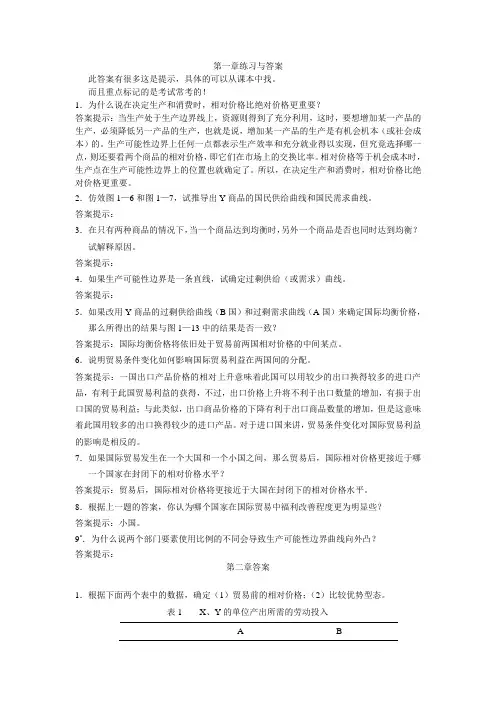
第一章练习与答案此答案有很多这是提示,具体的可以从课本中找。
而且重点标记的是考试常考的!1.为什么说在决定生产和消费时,相对价格比绝对价格更重要?答案提示:当生产处于生产边界线上,资源则得到了充分利用,这时,要想增加某一产品的生产,必须降低另一产品的生产,也就是说,增加某一产品的生产是有机会机本(或社会成本)的。
生产可能性边界上任何一点都表示生产效率和充分就业得以实现,但究竟选择哪一点,则还要看两个商品的相对价格,即它们在市场上的交换比率。
相对价格等于机会成本时,生产点在生产可能性边界上的位置也就确定了。
所以,在决定生产和消费时,相对价格比绝对价格更重要。
2.仿效图1—6和图1—7,试推导出Y商品的国民供给曲线和国民需求曲线。
答案提示:3.在只有两种商品的情况下,当一个商品达到均衡时,另外一个商品是否也同时达到均衡?试解释原因。
答案提示:4.如果生产可能性边界是一条直线,试确定过剩供给(或需求)曲线。
答案提示:5.如果改用Y商品的过剩供给曲线(B国)和过剩需求曲线(A国)来确定国际均衡价格,那么所得出的结果与图1—13中的结果是否一致?答案提示:国际均衡价格将依旧处于贸易前两国相对价格的中间某点。
6.说明贸易条件变化如何影响国际贸易利益在两国间的分配。
答案提示:一国出口产品价格的相对上升意味着此国可以用较少的出口换得较多的进口产品,有利于此国贸易利益的获得,不过,出口价格上升将不利于出口数量的增加,有损于出口国的贸易利益;与此类似,出口商品价格的下降有利于出口商品数量的增加,但是这意味着此国用较多的出口换得较少的进口产品。
对于进口国来讲,贸易条件变化对国际贸易利益的影响是相反的。
7.如果国际贸易发生在一个大国和一个小国之间,那么贸易后,国际相对价格更接近于哪一个国家在封闭下的相对价格水平?答案提示:贸易后,国际相对价格将更接近于大国在封闭下的相对价格水平。
8.根据上一题的答案,你认为哪个国家在国际贸易中福利改善程度更为明显些?答案提示:小国。
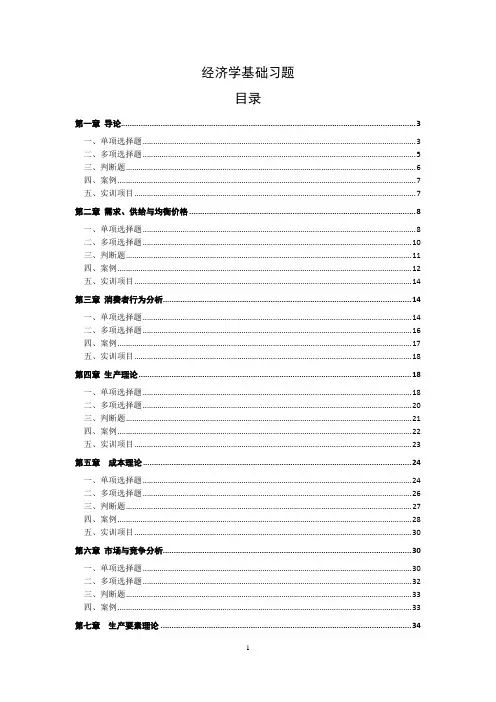
经济学基础习题目录第一章导论 (3)一、单项选择题 (3)二、多项选择题 (5)三、判断题 (6)四、案例 (7)五、实训项目 (7)第二章需求、供给与均衡价格 (8)一、单项选择题 (8)二、多项选择题 (10)三、判断题 (11)四、案例 (12)五、实训项目 (14)第三章消费者行为分析 (14)一、单项选择题 (14)二、多项选择题 (16)四、案例 (17)五、实训项目 (18)第四章生产理论 (18)一、单项选择题 (18)二、多项选择题 (20)三、判断题 (21)四、案例 (22)五、实训项目 (23)第五章成本理论 (24)一、单项选择题 (24)二、多项选择题 (26)三、判断题 (27)四、案例 (28)五、实训项目 (30)第六章市场与竞争分析 (30)一、单项选择题 (30)二、多项选择题 (32)三、判断题 (33)四、案例 (33)第七章生产要素理论 (34)一、单项选择题 (34)二.多项选择题 (36)三.判断正误题 (38)四、案例 (39)五、实训项目 (41)第八章国民收入的核算 (41)一、单项选择题 (41)二、多项选择题 (43)三、判断题 (45)四、案例 (46)五、实训项目 (48)第九章国民收入的决定理论 (49)一、单项选择题 (49)二、多项选择题 (50)三、判断题 (51)四、案例 (52)五、实训项目 (57)第十章经济周期与经济增长 (57)一、单项选择题 (57)二、多项选择题 (59)三、判断题 (61)四、案例 (61)五、实训项目 (63)第十一章通货膨胀与失业 (63)一、单项选择题 (63)二、多项选择题 (66)三、判断题 (67)四、案例 (68)五、实训项目 (68)第十二章宏观经济政策 (68)一、单项选择题 (68)二、多项选择题 (70)三、判断题 (71)四、案例 (72)五、实训项目 (75)经济学基础习题第一章导论一、单项选择题1.在任何一个经济中,( C )。
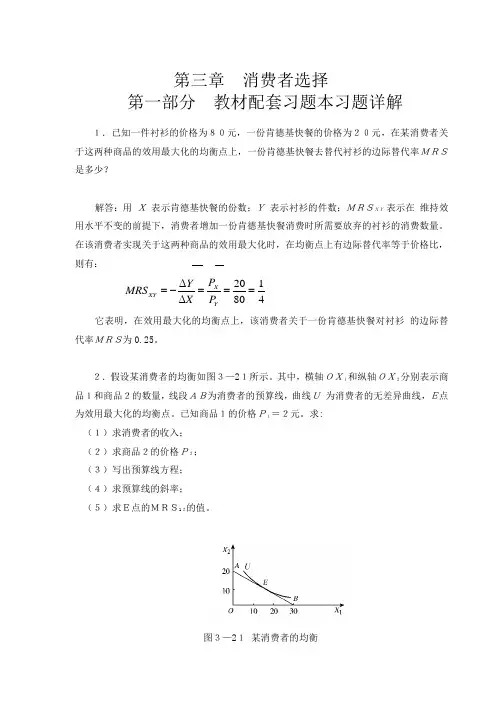
第三章 消费者选择第一部分 教材配套习题本习题详解1.已知一件衬衫的价格为80元,一份肯德基快餐的价格为20元,在某消费者关于这两种商品的效用最大化的均衡点上,一份肯德基快餐去替代衬衫的边际替代率MRS是多少?解答:用 X 表示肯德基快餐的份数;Y 表示衬衫的件数;MRSXY 表示在 维持效用水平不变的前提下,消费者增加一份肯德基快餐消费时所需要放弃的衬衫的消费数量。
在该消费者实现关于这两种商品的效用最大化时,在均衡点上有边际替代率等于价格比,则有:201804X XY Y P Y MRS X P ∆=-===∆ 它表明,在效用最大化的均衡点上,该消费者关于一份肯德基快餐对衬衫 的边际替代率MRS为0.25。
2.假设某消费者的均衡如图3—21所示。
其中,横轴OX1和纵轴OX2分别表示商品1和商品2的数量,线段AB为消费者的预算线,曲线U 为消费者的无差异曲线,E点为效用最大化的均衡点。
已知商品1的价格P1=2元。
求: (1)求消费者的收入; (2)求商品2的价格P2; (3)写出预算线方程; (4)求预算线的斜率; (5)求E点的MRS12的值。
图3—21 某消费者的均衡解答:(1)横轴截距表示消费者的收入全部购买商品1的数量为30单位,且已知P1=2元,所以,消费者的收入 M=2×30=60元。
(2)图3—1中纵轴截距表示消费者的收入全部购买商品2的数量为20单位,且由(1)已知收入 M=60元,所以,商品2的价格P 2=M 20=6020=3(元)。
(3)由于预算线方程的一般形式为 P 1X 1+P 2X 2=M,所以本题预算线方程具体写为:2X 1+3X 2=60。
(4)(4)将(3)中的预算线方程进一步整理为X 2=-23X 1+20。
所以,预算线的斜率为-23。
(5)在消费者效用最大化的均衡点E 上,有211212X PMRS X P ∆=-=∆,即无差异曲线斜率的绝对值即MRS 等于预算线斜率的绝对值P 1P 2。

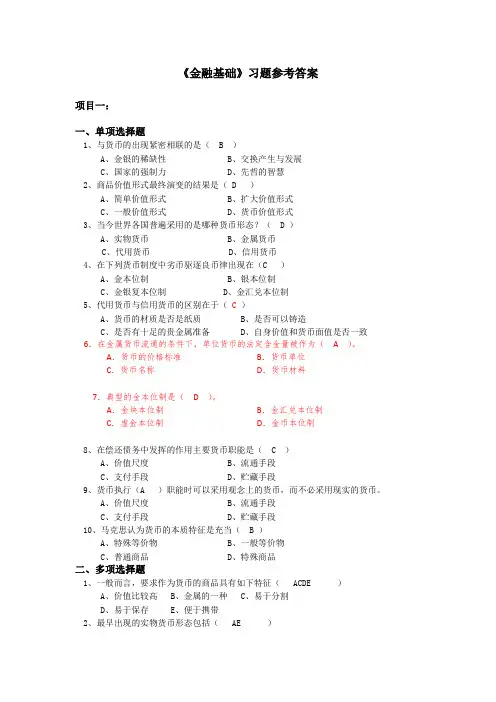
《金融基础》习题参考答案项目一:一、单项选择题1、与货币的出现紧密相联的是( B )A、金银的稀缺性B、交换产生与发展C、国家的强制力D、先哲的智慧2、商品价值形式最终演变的结果是( D )A、简单价值形式B、扩大价值形式C、一般价值形式D、货币价值形式3、当今世界各国普遍采用的是哪种货币形态?( D )A、实物货币B、金属货币C、代用货币D、信用货币4、在下列货币制度中劣币驱逐良币律出现在(C )A、金本位制B、银本位制C、金银复本位制D、金汇兑本位制5、代用货币与信用货币的区别在于(C)A、货币的材质是否是纸质B、是否可以铸造C、是否有十足的贵金属准备D、自身价值和货币面值是否一致6.在金属货币流通的条件下,单位货币的法定含金量被作为( A )。
A.货币的价格标准B.货币单位C.货币名称D.货币材料7.典型的金本位制是( D )。
A.金块本位制B.金汇兑本位制C.虚金本位制D.金币本位制8、在偿还债务中发挥的作用主要货币职能是( C )A、价值尺度B、流通手段C、支付手段D、贮藏手段9、货币执行(A )职能时可以采用观念上的货币,而不必采用现实的货币。
A、价值尺度B、流通手段C、支付手段D、贮藏手段10、马克思认为货币的本质特征是充当( B )A、特殊等价物B、一般等价物C、普通商品D、特殊商品二、多项选择题1、一般而言,要求作为货币的商品具有如下特征( ACDE )A、价值比较高B、金属的一种C、易于分割D、易于保存E、便于携带2、最早出现的实物货币形态包括( AE )A、贝壳B、黄金C、白银D、铜铁E、牲畜3.信用货币制度的特点有(BCE )。
A.黄金作为货币发行的准备B.贵金属非货币化C.国家强制力保证货币的流通D.金银储备保证货币的可兑换性E.货币发行通过信用渠道4、货币支付手段职能发挥作用的情形有( ABCDE )A、赋税B、各种劳动报酬C、国家财政D、银行信用E、房租5、对本位币的理解正确的是( ACDE )A、本位币是一国的基本通货B、本位币具有有限法偿性C、本位币具有无限法偿D、本位币的最小规格是一个货币单位E、货币本位制度的名称取决于本位币币材的名称。
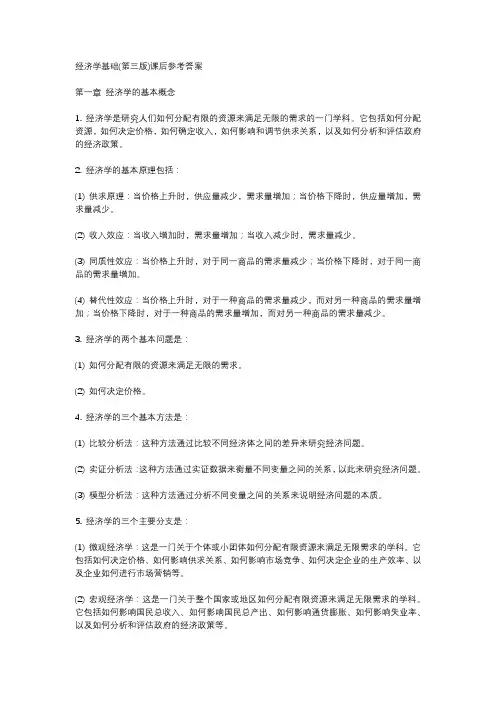
经济学基础(第三版)课后参考答案第一章经济学的基本概念1. 经济学是研究人们如何分配有限的资源来满足无限的需求的一门学科。
它包括如何分配资源,如何决定价格,如何确定收入,如何影响和调节供求关系,以及如何分析和评估政府的经济政策。
2. 经济学的基本原理包括:(1) 供求原理:当价格上升时,供应量减少,需求量增加;当价格下降时,供应量增加,需求量减少。
(2) 收入效应:当收入增加时,需求量增加;当收入减少时,需求量减少。
(3) 同质性效应:当价格上升时,对于同一商品的需求量减少;当价格下降时,对于同一商品的需求量增加。
(4) 替代性效应:当价格上升时,对于一种商品的需求量减少,而对另一种商品的需求量增加;当价格下降时,对于一种商品的需求量增加,而对另一种商品的需求量减少。
3. 经济学的两个基本问题是:(1) 如何分配有限的资源来满足无限的需求。
(2) 如何决定价格。
4. 经济学的三个基本方法是:(1) 比较分析法:这种方法通过比较不同经济体之间的差异来研究经济问题。
(2) 实证分析法:这种方法通过实证数据来衡量不同变量之间的关系,以此来研究经济问题。
(3) 模型分析法:这种方法通过分析不同变量之间的关系来说明经济问题的本质。
5. 经济学的三个主要分支是:(1) 微观经济学:这是一门关于个体或小团体如何分配有限资源来满足无限需求的学科。
它包括如何决定价格、如何影响供求关系、如何影响市场竞争、如何决定企业的生产效率、以及企业如何进行市场营销等。
(2) 宏观经济学:这是一门关于整个国家或地区如何分配有限资源来满足无限需求的学科。
它包括如何影响国民总收入、如何影响国民总产出、如何影响通货膨胀、如何影响失业率、以及如何分析和评估政府的经济政策等。
(3) 社会经济学:这是一门关于整个国家或地区如何分配有限资源来促进公平、正义和可持续发展的学科。
它包括如何影响人民生活水平、如何促进包容性发展、如何保障人权、以及如何应对气候变化、能源危机、贫困问题、人口问题等。
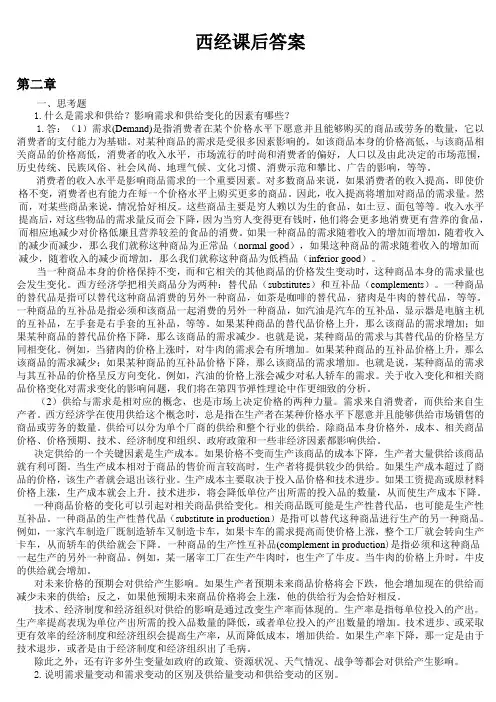
西经课后答案第二章一、思考题1.什么是需求和供给?影响需求和供给变化的因素有哪些?1.答:(1)需求(Demand)是指消费者在某个价格水平下愿意并且能够购买的商品或劳务的数量,它以消费者的支付能力为基础。
对某种商品的需求是受很多因素影响的,如该商品本身的价格高低,与该商品相关商品的价格高低,消费者的收入水平,市场流行的时尚和消费者的偏好,人口以及由此决定的市场范围,历史传统、民族风俗、社会风尚、地理气候、文化习惯、消费示范和攀比、广告的影响,等等。
消费者的收入水平是影响商品需求的一个重要因素。
对多数商品来说,如果消费者的收入提高,即使价格不变,消费者也有能力在每一个价格水平上购买更多的商品。
因此,收入提高将增加对商品的需求量。
然而,对某些商品来说,情况恰好相反。
这些商品主要是穷人赖以为生的食品,如土豆、面包等等。
收入水平提高后,对这些物品的需求量反而会下降,因为当穷人变得更有钱时,他们将会更多地消费更有营养的食品,而相应地减少对价格低廉且营养较差的食品的消费。
如果一种商品的需求随着收入的增加而增加,随着收入的减少而减少,那么我们就称这种商品为正常品(normal good),如果这种商品的需求随着收入的增加而减少,随着收入的减少而增加,那么我们就称这种商品为低档品(inferior good)。
当一种商品本身的价格保持不变,而和它相关的其他商品的价格发生变动时,这种商品本身的需求量也会发生变化。
西方经济学把相关商品分为两种:替代品(substitutes)和互补品(complements)。
一种商品的替代品是指可以替代这种商品消费的另外一种商品,如茶是咖啡的替代品,猪肉是牛肉的替代品,等等。
一种商品的互补品是指必须和该商品一起消费的另外一种商品,如汽油是汽车的互补品,显示器是电脑主机的互补品,左手套是右手套的互补品,等等。
如果某种商品的替代品价格上升,那么该商品的需求增加;如果某种商品的替代品价格下降,那么该商品的需求减少。

第一章边学边练一、单项选择题1.A 2.C 3.B 4. B 5. C6.A7.B8.D9.A 10.B二、多项选择题1.ABCEF 2.BCDEF 3. BCD 4. ACD5.BD6.ABD7.AC8.BCD9.ABC 10.ABC三、判断题1.F2.F3.F4.T5.F6.T7.F8.F9.T 10.T四、简答题1.答:微观经济学研究的基本内容包括: 均衡价格理论、消费者行为理论、生产理论、分配理论、市场失灵与微观经济政策。
2.答:经济学的基本问题在于一个人类面临的矛盾,就是资源的稀缺与欲望的无限性之间的矛盾。
这一问题的解决构成了经济学研究的基本内容,因此稀缺意味着人类必须做出选择,而资源的多种用途又为这种选择提供了可能性。
这个问题是要考察你对资源稀缺性的认识,对资源的稀缺性与多种用途又为这种选择提供了可能性。
3.答:实证分析和规范分析如果仅从概念上区分是比较简单的,他们无非是回答了不同的问题,“实证分析”回答的是是什么的问题,“规范分析”回答的是“应该是什么”的问题。
在回答这些不同问题时,很显然规范分析是存在一个价值判断体系的,实证分析不存在这种价值判断体系。
五、课堂实训1.经济学企图摆脱或排斥一切价值判断,只研究经济本身的内在规律,并根据这些规律,分析和预测人们经济行为的效果。
它要回答“是什么”的问题;规范经济学以一定的价值判断为基础,提出某些标准作为分析处理经济问题的标准,树立经济理论的前提,作为制定经济政策的依据,并研究如何才能符合这些标准。
它要回答“应该是什么”的问题。
从实证经济学的角度,要研究造成农产品的减产的因素,这种减产本身是否具有什么规律,等等。
从规范经济学的角度,我们研究造纸厂造成农产品减产到底是一件好事,还是一件坏事。
具有不同价值判断标准的人对这一问题会有不同的看法。
有人从造纸厂带动地方经济增长的角度出发,认为是一件好事;有人从造纸厂对当地环境的污染和农产品的减产的角度出发,认为是一件坏事。

SOLUTIONS TO TEXT PROBLEMS:Quick Quizzes1. When a competitive firm doubles the amount it sells, the price remains the same, so its totalrevenue doubles.2. The price faced by a profit-maximizing firm is equal to its marginal cost because if price were abovemarginal cost, the firm could increase profits by increasing output, while if price were belowmarginal cost, the firm could increase profits by decreasing output.A profit-maximizing firm decides to shut down in the short run when price is less than averagevariable cost. In the long run, a firm will exit a market when price is less than average total cost.3. In the long run, with free entry and exit, the price in the market is equal to both a firm’s marginalcost and its average total cost, as Figure 1 shows. The firm chooses its quantity so that marginal cost equals price; doing so ensures that the firm is maximizing its profit. In the long run, entry into and exit from the industry drive the price of the good to the minimum point on theaverage-total-cost curve.Figure 1Questions for Review1. A competitive firm is a firm in a market in which: (1) there are many buyers and many sellers inthe market; (2) the goods offered by the various sellers are largely the same; and (3) usually firms can freely enter or exit the market.2. Figure 2 shows the cost curves for a typical firm. For a given price (such as P*), the level of outputthat maximizes profit is the output where marginal cost equals price (Q*), as long as price is greater than average variable cost at that point (in the short run), or greater than average total cost (in the long run).Figure 23. A firm will shut down temporarily if the revenue it would get from producing is less than thevariable costs of production. This occurs if price is less than average variable cost.4. A firm will exit a market if the revenue it would get if it stayed in business is less than its total cost.This occurs if price is less than average total cost.5. A firm's price equals marginal cost in both the short run and the long run. In both the short runand the long run, price equals marginal revenue. The firm should increase output as long asmarginal revenue exceeds marginal cost, and reduce output if marginal revenue is less thanmarginal cost. Profits are maximized when marginal revenue equals marginal cost.6. The firm's price equals the minimum of average total cost only in the long run. In the short run,price may be greater than average total cost, in which case the firm is making profits, or price may be less than average total cost, in which case the firm is making losses. But the situation isdifferent in the long run. If firms are making profits, other firms will enter the industry, which will lower the price of the good. If firms are making losses, they will exit the industry, which will raise the price of the good. Entry or exit continues until firms are making neither profits nor losses. At that point, price equals average total cost.7. Market supply curves are typically more elastic in the long run than in the short run. In acompetitive market, since entry or exit occurs until price equals the minimum of average total cost, the supply curve is perfectly elastic in the long run.Problems and Applications1. A competitive market is one in which: (1) there are many buyers and many sellers in the market;(2) the goods offered by the various sellers are largely the same; and (3) usually firms can freelyenter or exit the market. Of these goods, bottled water is probably the closest to a competitive market. Tap water is a natural monopoly because there's only one seller. Cola and beer are not perfectly competitive because every brand is slightly different.2. Since a new customer is offering to pay $300 for one dose, marginal revenue between 200 and 201doses is $300. So we must find out if marginal cost is greater than or less than $300. To do this, calculate total cost for 200 doses and 201 doses, and calculate the increase in total cost.Multiplying quantity by average total cost, we find that total cost rises from $40,000 to $40,401, so marginal cost is $401. So your roommate should not make the additional dose.3. a. Remembering that price equals marginal cost when firms are maximizing profit, we knowthe marginal cost must be 30 cents, since that is the price.b. The industry is not in long-run equilibrium since price exceeds average total cost.4. Once you have ordered the dinner, its cost is sunk, so it does not represent an opportunity cost.As a result, the cost of the dinner should not influence your decision about stuffing yourself.5. Since Bob’s average total cost is $280/10 = $28, which is greater than the price, he will exit theindustry in the long run. Since fixed cost is $30, average variable cost is ($280 - $30)/10 = $25, which is less than price, so Bob won’t shut down in the short run.6. Here’s the table showing costs, revenues, and profits:a. The firm should produce 5 or 6 units to maximize profit.b. Marginal revenue and marginal cost are graphed in Figure 3. The curves cross at aquantity between 5 and 6 units, yielding the same answer as in part (a).c. This industry is competitive since marginal revenue is the same for each quantity. Theindustry is not in long-run equilibrium, since profit is positive.Figure 37. a. Figure 4 shows the short-run effect of declining demand for beef. The shift of theindustry demand curve from D1 to D2 reduces the quantity from Q1 to Q2 and reduces theprice from P1 to P2. This affects the firm, reducing its quantity from q1 to q2. Before thedecline in the price, the firm was making zero profits; afterwards, profits are negative, asaverage total cost exceeds price.Figure 4b. Figure 5 shows the long-run effect of declining demand for beef. Since firms were losingmoney in the short run, some firms leave the industry. This shifts the supply curve fromS1 to S3. The shift of the supply curve is just enough to increase the price back to itsoriginal level, P1. As a result, industry output falls still further, to Q3. For firms thatremain in the industry, the rise in the price to P1 returns them to their original situation,producing quantity q1 and earning zero profits.Figure 58. Figure 6 shows that although high prices cause an industry to expand, entry into the industryeventually returns prices to the point of minimum average total cost. In the figure, the industry is originally in long-run equilibrium. The industry produces output Q1, where supply curve S1intersects demand curve D1, and the price is P1. At this point the typical firm produces output q1.Since price equals average total cost at that point, the firm makes zero economic profit.Now suppose an increase in demand occurs, with the demand curve shifting to D2. This causes "high prices" in the industry, as the price rises to P2. It also causes the industry to increase output to Q2. With the higher price, the typical firm increases its output from q1 to q2, and now makes positive profits, since price exceeds average total cost.However, the positive profits that firms earn encourage other firms to enter the industry. Their entry, "an expansion in an industry," leads the supply curve to shift to S3. The new equilibrium reduces the price back to P1, "bringing an end to high prices and manufacturers' prosperity," since now firms produce q1 and earn zero profit again. The only long-lasting effect is that industryoutput is Q3, a higher level than originally.Figure 69. a. Figure 7 shows the typical firm in the industry, with average total cost ATC1, marginal costMC1, and price P1.b. The new process reduces Hi-Tech’s marginal cost to MC2 and its average total cost to ATC2,but the price remains at P1 since other firms cannot use the new process. Thus Hi-Techearns positive profits.c. When the patent expires and other firms are free to use the technology, all firms’average-total-cost curves decline to ATC2, so the market price falls to P3 and firms earn noprofits.Figure 710. The rise in the price of petroleum increases production costs for individual firms and thus shifts theindustry supply curve up, as shown in Figure 8. The typical firm's initial marginal-cost curve is MC1 and its average-total-cost curve is ATC1. In the initial equilibrium, the industry supply curve, S1, intersects the demand curve at price P1, which is equal to the minimum average total cost of the typical firm. Thus the typical firm earns no economic profit.The increase in the price of oil shifts the typical firm's cost curves up to MC2 and ATC2, and shifts the industry supply curve up to S2. The equilibrium price rises from P1 to P2, but the price does not increase by as much as the increase in marginal cost for the firm. As a result, price is less than average total cost for the firm, so profits are negative.In the long run, the negative profits lead some firms to exit the industry. As they do so, theindustry-supply curve shifts to the left. This continues until the price rises to equal the minimum point on the firm's average-total-cost curve. The long-run equilibrium occurs with supply curve S3, equilibrium price P3, industry output Q3, and firm's output q3. Thus, in the long run, profits arezero again and there are fewer firms in the industry.Figure 811. a. Figure 9 illustrates the situation in the U.S. textile industry. With no international trade,the market is in long-run equilibrium. Supply intersects demand at quantity Q1 and price$30, with a typical firm producing output q1.Figure 9b. The effect of imports at $25 is that the market supply curve follows the old supply curve upto a price of $25, then becomes horizontal at that price. As a result, demand exceedsdomestic supply, so the country imports textiles from other countries. The typicaldomestic firm now reduces its output from q1 to q2, incurring losses, since the large fixedcosts imply that average total cost will be much higher than the price.c. In the long run, domestic firms will be unable to compete with foreign firms because theircosts are too high. All the domestic firms will exit the industry and other countries willsupply enough to satisfy the entire domestic demand.12. a. Figure 10 shows the current equilibrium in the market for pretzels. The supply curve, S1,intersects the demand curve at price P1. Each stand produces quantity q1 of pretzels, sothe total number of pretzels produced is 1,000 x q1. Stands earn zero profit, since priceequals average total cost.b. If the city government restricts the number of pretzel stands to 800, the industry-supplycurve shifts to S2. The market price rises to P2, and individual firms produce output q2.Industry output is now 800 x q2. Now the price exceeds average total cost, so each firm ismaking a positive profit. Without restrictions on the market, this would induce other firmsto enter the market, but they cannot, since the government has limited the number oflicenses.c. The city could charge a license fee for the licenses. Since it is a lump-sum fee for thelicense, not based on the quantity of sales, such a tax has no effect on marginal cost, sowon't affect the firm's output. It will, however, reduce the firm's profits. As long as thefirm is left with a zero or positive profit, it will continue to operate. So the license fee thatbrings the most money to the city is to charge each firm the amount (P2 - ATC2)q2, theamount of the firm's profit.Figure 1013. a. Figure 11 illustrates the gold market (industry) and a representative gold mine (firm).The demand curve, D1, intersects the supply curve at industry quantity Q1 and price P1.Since the industry is in long-run equilibrium, the price equals the minimum point on therepresentative firm's average total cost curve, so the firm produces output q1 and makeszero profit.b. The increase in jewelry demand leads to an increase in the demand for gold, shifting thedemand curve to D2. In the short run, the price rises to P2, industry output rises to Q2,and the representative firm's output rises to q2. Since price now exceeds average totalcost, the representative firm now earns positive profits.c. Since gold mines are earning positive economic profits, over time other firms will enter theindustry. This will shift the supply curve to the right, reducing the price below P2. Butit's unlikely that the price will fall all the way back to P1, since gold is in short supply.Costs for new firms are likely to be higher than for older firms, since they'll have to discovernew gold sources. So it's likely that the long-run supply curve in the gold industry isupward sloping. That means the long-run equilibrium price will be higher than it wasinitially.Figure 1114. a. Figure 12 shows cost curves for a California refiner and a non-California refiner. Since theCalifornia refiner has access to lower-cost oil, its costs are lower.Figure 12b. In long-run equilibrium, the price is determined by the costs of non-California refiners,since California refiners cannot supply the entire market. The market price will equal theminimum average total cost of the other refiners; they will thus earn zero profits. SinceCalifornia refiners have lower costs, they will earn positive profits, equal to (P* - ATC C) xQ C.c. Yes, there is a subsidy to California refiners that is not passed on to consumers. Thesubsidy accounts for the long-run profits of the California refiners. It arises simplybecause the oil cannot be exported.。
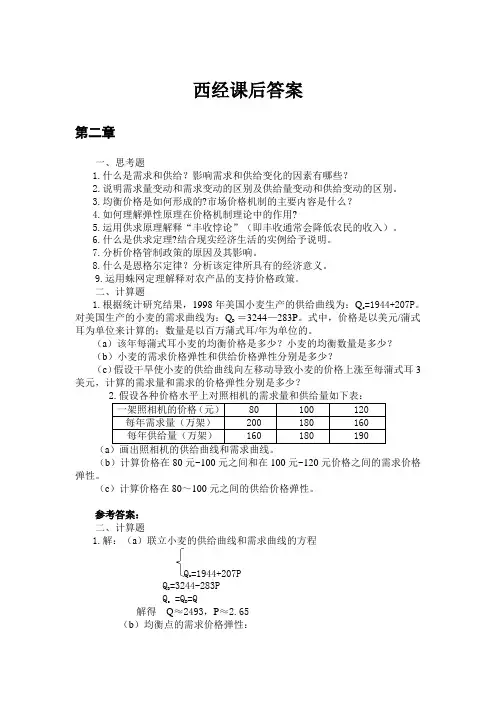
西经课后答案第二章一、思考题1.什么是需求和供给?影响需求和供给变化的因素有哪些?2.说明需求量变动和需求变动的区别及供给量变动和供给变动的区别。
3.均衡价格是如何形成的?市场价格机制的主要内容是什么?4.如何理解弹性原理在价格机制理论中的作用?5.运用供求原理解释“丰收悖论”(即丰收通常会降低农民的收入)。
6.什么是供求定理?结合现实经济生活的实例给予说明。
7.分析价格管制政策的原因及其影响。
8.什么是恩格尔定律?分析该定律所具有的经济意义。
9.运用蛛网定理解释对农产品的支持价格政策。
二、计算题1.根据统计研究结果,1998年美国小麦生产的供给曲线为:Q s=1944+207P。
对美国生产的小麦的需求曲线为:Q D =3244—283P。
式中,价格是以美元/蒲式耳为单位来计算的;数量是以百万蒲式耳/年为单位的。
(a)该年每蒲式耳小麦的均衡价格是多少?小麦的均衡数量是多少?(b)小麦的需求价格弹性和供给价格弹性分别是多少?(c)假设干旱使小麦的供给曲线向左移动导致小麦的价格上涨至每蒲式耳3美元,计算的需求量和需求的价格弹性分别是多少?(a(b)计算价格在80元~100元之间和在100元~120元价格之间的需求价格弹性。
(c)计算价格在80~100元之间的供给价格弹性。
参考答案:二、计算题1.解:(a)联立小麦的供给曲线和需求曲线的方程Q s=1944+207PQ D=3244-283PQ s =Q D=Q解得Q≈2493,P≈2.65(b)均衡点的需求价格弹性:E d=ΔQ/Q÷ΔP/P=ΔQ/ΔP×P/Q=-283×(2.65/2493)=-0.3均衡点的供给价格弹性:E s=ΔQ/Q÷ΔP/P=ΔQ/ΔP×P/Q=207×(2.65/2493)=0.22(c)将小麦的价格P每蒲式耳3美元代入需求曲线的方程Q D=3244-283P,解得Q D=2395;新均衡点的需求价格弹性:E d=ΔQ/Q÷ΔP/P=ΔQ/ΔP×P/Q=-283×(3/2395)=-0.3542.解:(a)照相机的供给曲线和需求曲线如下图所示:(b)80元~100元之间E D=ΔQ/ΔP×(P1+P2)/(Q1+Q2)=(200-180)/(80-100)×(100+80)/(180+200)=-0.47100元~120元之间E D=ΔQ/ΔP×(P1+P2)/(Q1+Q2)=(180-160)/(100-120)×(120+100)/(160+180)=-0.65(c)80~100元之间E S=ΔQ/ΔP×(P1+P2)/(Q1+Q2)=(180-160)/(100-80)×(80+100)/(160+180)=0.53第三章效用论与消费者行为一、思考题1.分析基数效用论与序数效用论的异同之处。
第一章1,一般的,相对于人类社会的无限欲望而言,生产人类所需物品的资源总是不足的。
这就是资源的稀缺性。
资源的稀缺性不是指资源绝对数量的多少,而是指相对于无限的欲望而言,再多的资源也是不足的。
即稀缺性是就相对意义而言的。
欲望的基本特点在于无限性,即人们得欲望永远没有完全得到满足的时候,人的欲望要用各种物品或劳务来满足,而物品要用各种资源来生产,这些资源包括人力资源和自然资源。
然而,人类赖以生存的地球的资源是有限的,这样无限的欲望与有限的资源的矛盾就形成了经济学所说的稀缺性。
2,人类社会作面临的基本问题。
面对资源稀缺性的事实,人类社会都必须面对和解决三个基本的经济问题。
他们是:生产什么,如何生产和为谁生产。
(1)生产什么商品和生产多少。
一个社会必须决定,在诸多可能的物品和劳务中,每一种应该生产多少以及何时生产,生产多少消费品和投资品。
(2)如何生产物品。
一个社会必须决定谁来生产,使用何种资源,以及采用何种生产技术。
(3)为谁生产。
谁来享用经济活动的成果?收入和财富的分配是公平合理的吗?社会产品如何在不同的居民之间进行分配?是否会出现贫富差距?3,微观经济学以单个经济单位为研究对象,通过研究单个经济单位的经济行为和相应的经济变量数值的决定来说明价格机制如何解决社会的资源配置问题。
可见,微观经济学研究的对象是单个经济单位的经济行为,即家庭和企业的经济行为。
微观经济学解决的问题是资源配置。
微观经济学的中心理论是价格理论。
微观经济学的研究方法是个量分析。
相对而言,宏观经济学以整个国民经济为研究对象,通过研究经济中各有关总量的决定及其变化,来说明资源如何才能得到充分利用。
可见,与微观经济学的几个方面相对应的,宏观经济学研究的对象是整个经济。
而不是经济中的各个单位。
宏观经济学解决的问题是资源利用。
它把资源配置最为既定的前提,研究现有资源未能得到充分利用的原因,大到充分利用的途径,以及如何增长等问题。
宏观经济学的中心理论是国民收入决定理论。
网络经济学第三版第二章课后答案Chapter1网络经济学概论1.网络经济与传统经济的关系如何?关于网络经济与传统经济的关系,我国著名经济学家乌家培形象化的比喻为“水泥”加“鼠标”的互动关系。
也就是说,网络经济不可能完全替代传统经济,网络经济的发展需要传统经济的物质支持、人才支持和市场支持,传统经济的革新则需要以信息技术为核心的网络经济和电子商务的促进和带动。
2网络经济下的市场表现出哪些特征?与传统经济相比,网络经济表现出大量的全新的市场特性:市场瞬息万变、不可捉摸;市场规模以几何级数的速度增长;“只有第一,没有第二”,赢家就会通吃;市场流通渠道无限透明;竞争与垄断同时加剧,协同竞争与创新竞争将成为竞争的主要形式等等。
3.网络经济学的研究对象是什么?研究对象:网络经济学是一门新兴的经济学分支,其主要研究在网络经济下资源的有效配置和充分利用问题,以及网络经济发展中遇到的种种现实经济问题。
4.试述网络经济从哪些方面正在改变着世界经济的运作方式?网络经济对世界经济的影响是全方位的:(1)网络经济的发展加快了经济全球化进程,改变了人类的生产、流通、分配、消费方式,出现了虚拟企业、网络市场、电子商务、网络消费等新的经济现象。
(2)网络经济使产业结构向高级化、劳动结构向知识密集化方向转变。
(3)商务活动集信息流、资金流、物流于一体,其中信息流起主导作用。
(4)经济网络化、全球化导致经济发展的高度开放,从而要求主权国家增强政策的调控能力,善于在不可避免的外部冲击下来实现自己的社会经济目标。
(5)竞争与合作并重、注重速度、讲求创新。
传统工业社会的竞争是一种盲目的对抗性竞争。
(6)网络经济促使企业变革战略思想、管理理念、运行方式、组织结构,以提升其竞争力。
(7)网络经济促使金融与贸易的一系列变化。
Chapter2网络经济下的产品和需求1、网络经济是否会颠覆经济运行的基本规律?参考答案:网络经济不会颠覆经济运行的基本规律,网络经济仍然要以强大的实物经济作为基础。
一、单项选择题1.C2.A3.D4.B5.A6.A7.D8.C9.D 10.B二、判断题1.√2.X3.X4.X5.X6.√三、简答题1.稀缺性产生于人类欲望的无限性与资源的有限性这一矛盾。
稀缺性强调的不是资源绝对数量的多少,而是相对于欲望无限性的有限性;稀缺性是人类社会永远存在的问题,任何人在任何社会、任何时候都无法摆脱稀缺性,相对于人们的愿望资源总是稀缺的;经济学正是由于稀缺性的存在而产生的。
没有稀缺性就没有经济学存在的必要。
2.机会成本是指当一项资源被用于某一活动时所放弃的将该项资源用于其他活动中所能获得的最大的收益。
3. 实证分析法不带价值判断,所表述的问题可以用事实、证据或者从逻辑上加以证明或证伪,即“是什么”;而规范分析是以一定的价值判断为基础,提出分析问题的理论标准,并研究如何才能符合这些标准,即“应该是什么”,它研究的内容没有客观性,其结论也无法通过事实来直接检验。
一、单项选择题1.A2.D3.A4.A5.C6.A7.B8.D9.A 10.C二、判断题1.X2.X3.X4.√5.√6.√7.X8.X9.X 10.√三、简答题1.影响需求的因素:商品自身的价格、消费者的收入、相关商品价格、消费者的偏好、消费者的预期;影响供给的因素:商品本身的价格、生产要素的价格、相关商品价格、技术水平、对未来的预期;2.根据凡勃伦效应,消费者购买高档商品大多是为了满足炫耀的需求。
当高档名牌服装在超市打折后,消费者对这种商品的偏好发生了变化,使得需求曲线左移。
所以,一方面,根据需求规律,打折后该商品的需求量有所上升,另一方面,偏好的变化使得需求减少了,如果需求的减少超过了需求量的增加,该商品打折后反而卖不出去。
3.均衡价格是指一种商品需求量与供给量相等时的价格。
供需定理:(1)需求的变动引起均衡价格和均衡数量同方向变动(2)供给的变动引起均衡价格反方向变动和均衡数量的同方向变动(3)需求和供给同方向变动引起均衡数量同方向变动,但均衡价格的变动则不确定(存在上升、下降或不变三种可能)。
经济学基础习题(三)一、单项选择题(每小题备选答案中只有一个正确答案,请将选定的答案填在对应的答题卡上。
每小题 1 分,共 15分)1、当总效用达到最大值拐点时,边际效用()。
A、最大B、最小C、为零D、不变2、当需求曲线是平行于横轴的直线时()。
A、需求价格弹性为零B、需求价格弹性为无穷大C、需求价格弹性为-1D、供给无弹性3、X产品的替代品的价格上升则X产品需求量()。
A、增加B、减少C、先增后减D、先减后增4、新古典经济学派的代表人物是()。
A、配第B、马歇尔C、斯密D、李嘉图5、被称为“现代经济学之父”的经济学家是()。
A、配第B、马歇尔C、斯密D、李嘉图6、“政府在扩大就业方面还应该起到更大的作用”采用的是()。
A、实证分析方法B、不确定C、定性分析方法D、规范分析方法7、如果一个消费者想要一单位甲产品的心情甚于想要一单位乙产品的心情,这说明()。
A、产品甲的效用高B、产品甲的价格低C、产品甲紧缺D、产品甲更能满足精神需要8、消费者剩余是指()。
A、消费者消费剩余的部分B、消费者的主观感受C、剩余货币D、实际所得9、供给曲线反应()。
A、价格与供给数量间反方向变动关系B、收入与供给数量间的正比例关系C、消费与储蓄间的循环关系D、价格与供给数量间同方向变动关系10、厂商利润最大化原则是()。
A、MR>MCB、MR<MCC、MR=MCD、MR=AC11、一个经济周期通常分成四个阶段()。
A、萧条、繁荣、衰退、复苏B、复苏、繁荣、萧条、衰退C、萧条、复苏、繁荣、衰退D、繁荣、衰退、复苏、萧条12、当边际产量大于平均产量时,平均产量()。
A、先增后减B、递增C、递减D、先减后增13、完全竞争市场中,在MR=MC的均衡产量水平上,厂商()。
A、得到最大利润B、若获得利润,则利润最大;若亏损,则亏损最小C、得到最小亏损D、得到最大利润的同时亏损最小14、下列哪项不属于引起市场失灵的原因()。
第一章1,一般的,相对于人类社会的无限欲望而言,生产人类所需物品的资源总是不足的。
这就是资源的稀缺性。
资源的稀缺性不是指资源绝对数量的多少,而是指相对于无限的欲望而言,再多的资源也是不足的。
即稀缺性是就相对意义而言的。
欲望的基本特点在于无限性,即人们得欲望永远没有完全得到满足的时候,人的欲望要用各种物品或劳务来满足,而物品要用各种资源来生产,这些资源包括人力资源和自然资源。
然而,人类赖以生存的地球的资源是有限的,这样无限的欲望与有限的资源的矛盾就形成了经济学所说的稀缺性。
2,人类社会作面临的基本问题。
面对资源稀缺性的事实,人类社会都必须面对和解决三个基本的经济问题。
他们是:生产什么,如何生产和为谁生产。
(1)生产什么商品和生产多少。
一个社会必须决定,在诸多可能的物品和劳务中,每一种应该生产多少以及何时生产,生产多少消费品和投资品。
(2)如何生产物品。
一个社会必须决定谁来生产,使用何种资源,以及采用何种生产技术。
(3)为谁生产。
谁来享用经济活动的成果?收入和财富的分配是公平合理的吗?社会产品如何在不同的居民之间进行分配?是否会出现贫富差距?3,微观经济学以单个经济单位为研究对象,通过研究单个经济单位的经济行为和相应的经济变量数值的决定来说明价格机制如何解决社会的资源配置问题。
可见,微观经济学研究的对象是单个经济单位的经济行为,即家庭和企业的经济行为。
微观经济学解决的问题是资源配置。
微观经济学的中心理论是价格理论。
微观经济学的研究方法是个量分析。
相对而言,宏观经济学以整个国民经济为研究对象,通过研究经济中各有关总量的决定及其变化,来说明资源如何才能得到充分利用。
可见,与微观经济学的几个方面相对应的,宏观经济学研究的对象是整个经济。
而不是经济中的各个单位。
宏观经济学解决的问题是资源利用。
它把资源配置最为既定的前提,研究现有资源未能得到充分利用的原因,大到充分利用的途径,以及如何增长等问题。
宏观经济学的中心理论是国民收入决定理论。
最后,宏观经济学的研究方法是总量分析,总量是指能反映整个经济运行情况的经济变量。
以上分析可以看出,宏观经济学与微观经济学在研究对象、解决问题、中心理论、研究方法方面的不同。
但并不是说二者是完全割裂开的。
实际上。
宏观经济学与微观经济学有着密切的相互联系。
可以说,微观经济学是宏观经济学的基础,对总体的分析离不开对个体的分析,但宏观经济学不是微观经济学的简单相加,他们之间的关系是相互联系又相互区别的。
4,在经济学中,经济分析的基本工具是模型。
在经济学中的模型是一种组织框架,它可以搭建我们思考问题的途径。
模型忽略现实世界的某些细节而集中研究本质问题,以达到简化的目的。
生活中模型比如地图。
一,1,人们决定多生孩子。
即人们偏好更多的孩子,对孩子的需求增加。
2,钢铁工人的罢工提高了钢材价格。
工人罢工引起工资提高,即投入品的价格提高,从而提高钢材的价格。
供给的价格提高,供给量减小。
3,工程师开发生产出新的自动化机器用于家庭旅行车。
技术提高,供给量提高。
4,客货两用车价格上升。
价格上升,需求降低。
5,股市崩溃减少了人们的财产。
收入减少,需求降低。
由图可知,这个市场的均衡价格是6美元,均衡数量是80个。
如果市场上实际价格高于均衡价格,需求减少,供给增加,最终会回到均衡位置。
如果市场上实际价格低于均衡价格,则需求增加,供给减少,最终会回到均衡位置。
三,(1)供给曲线是水平的(对于反需求函数则是竖直的),也就是说供给量不随价格变化而变化。
(2)均衡价格为8美元,均衡数量是8000张。
(3)需求表为:第三章1,在效用最大化的均衡点,有:RCS12=P1/P2,所以在效用最大化的均衡点上,一份肯德基快餐对衬衫的边际替代率即为其价格之比,RCS12=20/80=1/4 。
2,(1)消费者的收入:30*2=60元(2)商品2的价格:60/20=3元(3)预算线方程:60=2X1+3X2(4)预算线的斜率:-P1/P2=-2/3(5)E点RCS12值:RCS12=P1/P2=2/3(2)画出需求曲线和市场需求曲线第四章(2),该生产函数表现了出边际报酬递减,即可变要素的边际产量递减,从第5单位开始递减。
2,平均产量为aI L K A Q -⎪⎭⎫⎝⎛=,边际产量为a a K AaLQ --='113,(1)可变成本部分为Q Q Q VC 171023+-=。
不变成本FC=66 (2)Q Q Q TVC 171023+-=QQ Q AC 6617102++-= 17102+-=Q Q AVC QAFC 66=172032+-=Q Q MC第五章1,在MC=MR 处对应的产量水平即为企业利润最大化的产量水平。
2,(1)由短期成本函数得MC=0.3Q 2-4Q+15=P=55Q=20 利润为PQ-C=55*20-310=790 (2)厂商必须停产的条件是:在MC=MR 的情况下出现P=A VC (平均可变成本) MC=0.3Q 2-4Q+15=P=0.1Q 2-2Q+15得到:Q=10 P=5 所以市场价格P=5时,厂商必须停产。
3,专利法和著作权法是政府为公共利益创造垄断的一个例子。
当一个制药公司发明了一种新药,它就可以向政府盛情专利。
如果政府认为这种要是真正原创性的,就批准专利,该专利给予该公司在若干年中排他性的生产并销售这种药的权利。
制造这种垄断虽然从静态上看会形成垄断价格,造成市场资源配置的扭曲,但从动态来看,它可以起到激励创新的作用,而这一方面的作用对于整个经济的长期发展是相当重要的。
所以说制造这种垄断也有其积极的一面。
可见在厂商数目和进入一个行业的难易程度方面两类市场较相似。
都是有很多的厂商,且进入行业较容易。
但在产品差别程度和对价格控制的程度方面则有显著的不同。
第六章1,厂商的要素使用原则:厂商对要素的需求是引致需求,那么厂商选择要素的使用量是也就遵循利润最大化原则,即使要素的“边际收益”等于要素的“边际成本”。
特别的在完全竞争产品市场和完全竞争要素市场上,要素边际收益等于该要素的边际产量乘以产品的价格。
而边际成本则恰为要素的价格。
所以边际收益等于边际成本,也就是要素的边际产量乘以产品的价格等于要素的价格。
2,边际产量为MP=-0.03L2+2L+36厂商的要素使用原则为MP*P=P L所以(-0.03L2+2L+36)*10=48L=80 所以该厂商的最优劳动使用量是80。
3,之所以会出现向后弯曲的劳动供给曲线,是因为当工资率提高时,对劳动供给所产生的替代效应和收入效应成相反的作用。
工资率变动的替代效应是指工资率变动对劳动者消费休闲与收入之间的替代所产生的影响。
较高的工资率意味着休闲变得相对昂贵,因而若工资率提高,则劳动者倾向于用消费其他的商品来代替闲暇。
所以,工资率提高的替代效应是的劳动供给量增加。
反之亦然。
工资率变动的收入效应是指工资率变动引起的收入变动对劳动供给所产生的影响。
如果劳动者的工作时间保持不变,那么工资率的提高使得劳动者的收入提高。
收入提阿高将市的劳动者能够购买更多的商品,其中包括购买更多的闲暇时间。
闲暇时间增加意味着劳动时间减少。
因此,工资率提高的收入效应使得劳动时间减少,反之亦然。
由此可见,工资率提高的替代效应和收入效应方向相反,工资提高是否使得闲暇时间或工作时间减少,取决于替代效应和收入效应的程度。
一般来说,工资率较低时,工资率提高对于劳动者的收入影响不大,工资率提高的收入效应小于替代效应,因而劳动的功绩曲线向右上方倾斜。
但是,当工资率上升到一定程度以后,工作较少的时间就可以维持较好的生活水平,工资率提高的收入效应强度增加,超过替代效应,从而使得劳动供给曲线开始向右下方倾斜。
因此,随着工资率提高,劳动者的劳动供给曲线呈现向后弯曲的形状。
第七章1,垄断和不完全竞争所导致的四个主要问题。
垄断和其他不完全竞争行业常常是低效的。
这种低效率主要有四个来源:产出受到限制、管理松懈、研究与开发的减缩和寻租。
产出受到限制,垄断厂商与完全竞争厂商的一点不同在于它可以操控自己的价格,而垄断厂商控制价格是通过限制产量来实现的,这样,他们就可以以垄断价格获得超额利润了。
管理松懈,任何且无论选择何种产量水平,都想使生产成本最小化。
但是在现实中,那些不通过激烈竞争就能赚很多钱的企业,往往缺乏是成本尽可能低的动力。
这种由于企业缺乏竞争压力而导致的低效率成为管理松懈。
而垄断和不完全竞争的厂商则由于其不能充分竞争,处于这样一种状态当中。
研究与开发的缩减,竞争推动企业开发新产品和研究成本更低的生产方法。
与此相反,垄断企业可能更愿意坐享现有的利润,而不是积极推动技术进步。
实际上,这个结论不是绝对的,垄断厂商更有资力进行研究与开发,且从市场中失去市场地位的损失比竞争厂商更多,所以,从某种程度上来说,垄断厂商更有动力进行研究与开发。
寻租,通过寻求或维持在行业内的垄断地位来寻求或维持业已存在的租金的活动称为寻租。
在这一过程中,垄断企业将资源花费在非生产性活动上。
2,自然垄断行业最大的特点就是规模报酬递增,即随着规模的扩大平均成本不断下降,这也是该行业能形成自然垄断的原因。
由于平均成本不断下降,增加一单位产量所引起的成本必须更低,才能保证对于每一单位产量的成本(平均成本)下降,也就是说,边际成本必须在平均成本以下,才能保证平均成本是下降的,从而保证它是以规模报酬递增特点的自然垄断。
3,反垄断政策一方面可以让厂商集中精力生产消费者需要的产品,而花较少的精力在减少竞争的策略上。
而另一方面,反垄断政策又在某些方面影响了经济效率,作为一项固定的政策,它阻碍了一些有效率的经济行为的进行,比如涉及到某些有效率合同的合法性。
第八章1,列出GDP的四个组成部分,并举例支出法计算GDP就是核算经济社会在一定时期内消费、投资、政府购买以及出口这几方面支出的总和。
消费支出包括购买耐用消费品(如小汽车、电视机、洗衣机等)、非耐用消费品(如食物、衣物)和劳务(如医疗、旅游、理发等)的支出。
投资导致增加或更换资本资产(包括厂房、住宅、机械设备及存货)的支出。
投资包括固定资本投资和存货投资两大类。
固定资产投资指新厂房、新设备、新商业用房以及新住宅的增加。
存货投资是企业掌握的存货价值的增加或减少。
政府对物品和劳务的购买是指各级政府购买物品和劳务的支出,如政府花钱设立法院、提供国防设施、建筑道路、开办学校等方面支出。
净出口指进出口的差额。
进口比如对国外高科技产品的进口,出口则比如我国初级产品如衣物等的出口,所有的出口与所有的进口即为净出口。
2,用支出法核算GDP 时,转移支付不包括在内。
理由是相对政府购买是通过雇请公务人员、教师,建立公共设施,建造舰队等为社会提供了服务,转移支付只是简单的把收入从一些人或一些组织转移到另一些人或另一些组织,没有相应的物品或劳务的交换发生,并没有创造价值。